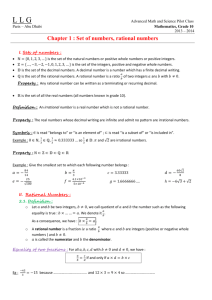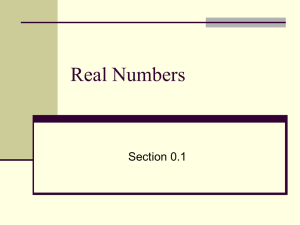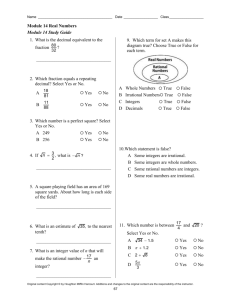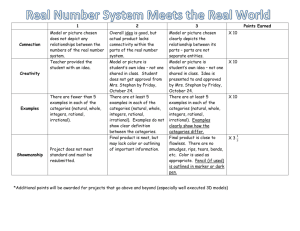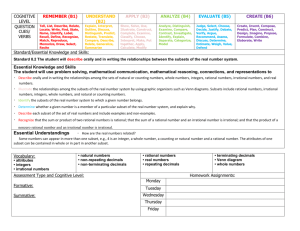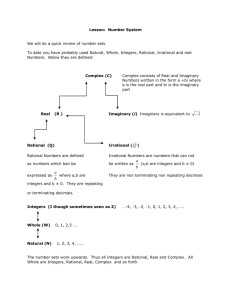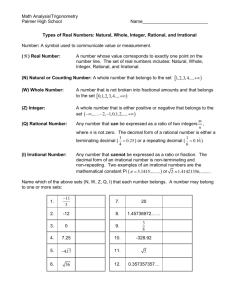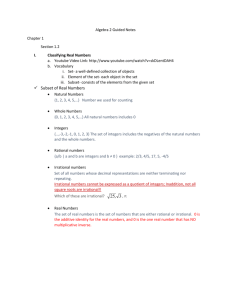Mathematics has its own language with numbers as the alphabet
advertisement
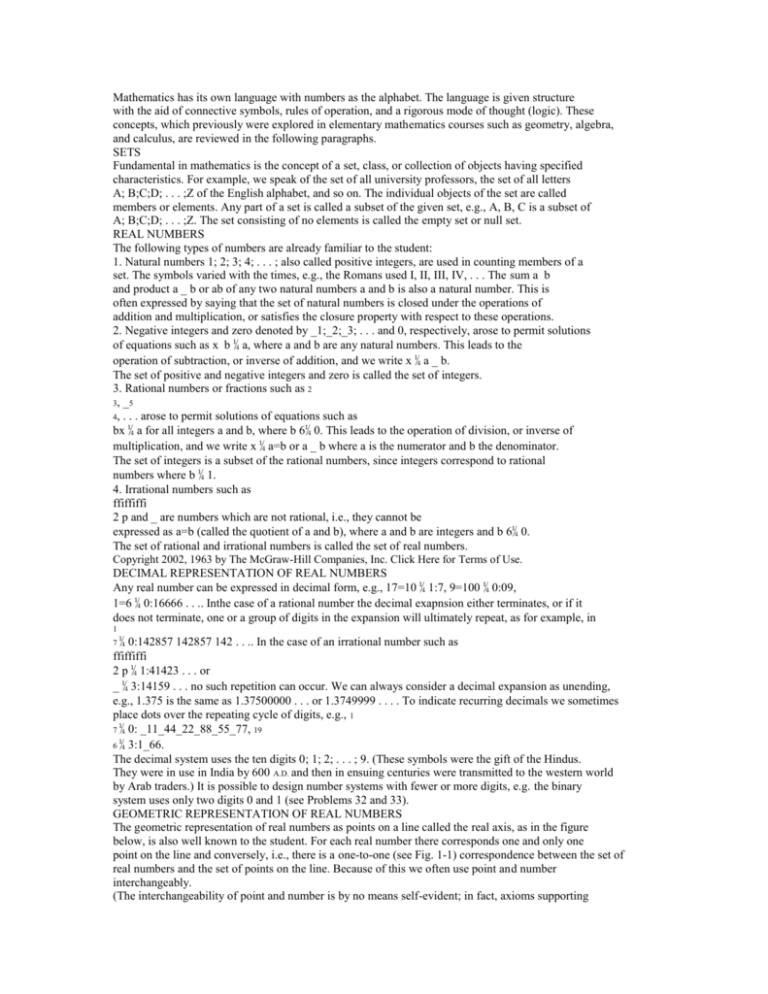
Mathematics has its own language with numbers as the alphabet. The language is given structure with the aid of connective symbols, rules of operation, and a rigorous mode of thought (logic). These concepts, which previously were explored in elementary mathematics courses such as geometry, algebra, and calculus, are reviewed in the following paragraphs. SETS Fundamental in mathematics is the concept of a set, class, or collection of objects having specified characteristics. For example, we speak of the set of all university professors, the set of all letters A; B;C;D; . . . ;Z of the English alphabet, and so on. The individual objects of the set are called members or elements. Any part of a set is called a subset of the given set, e.g., A, B, C is a subset of A; B;C;D; . . . ;Z. The set consisting of no elements is called the empty set or null set. REAL NUMBERS The following types of numbers are already familiar to the student: 1. Natural numbers 1; 2; 3; 4; . . . ; also called positive integers, are used in counting members of a set. The symbols varied with the times, e.g., the Romans used I, II, III, IV, . . . The sum a b and product a _ b or ab of any two natural numbers a and b is also a natural number. This is often expressed by saying that the set of natural numbers is closed under the operations of addition and multiplication, or satisfies the closure property with respect to these operations. 2. Negative integers and zero denoted by _1;_2;_3; . . . and 0, respectively, arose to permit solutions of equations such as x b ¼ a, where a and b are any natural numbers. This leads to the operation of subtraction, or inverse of addition, and we write x ¼ a _ b. The set of positive and negative integers and zero is called the set of integers. 3. Rational numbers or fractions such as 2 3, _ 5 4, . . . arose to permit solutions of equations such as bx ¼ a for all integers a and b, where b 6¼ 0. This leads to the operation of division, or inverse of multiplication, and we write x ¼ a=b or a _ b where a is the numerator and b the denominator. The set of integers is a subset of the rational numbers, since integers correspond to rational numbers where b ¼ 1. 4. Irrational numbers such as ffiffiffi 2 p and _ are numbers which are not rational, i.e., they cannot be expressed as a=b (called the quotient of a and b), where a and b are integers and b 6¼ 0. The set of rational and irrational numbers is called the set of real numbers. Copyright 2002, 1963 by The McGraw-Hill Companies, Inc. Click Here for Terms of Use. DECIMAL REPRESENTATION OF REAL NUMBERS Any real number can be expressed in decimal form, e.g., 17=10 ¼ 1:7, 9=100 ¼ 0:09, 1=6 ¼ 0:16666 . . .. Inthe case of a rational number the decimal exapnsion either terminates, or if it does not terminate, one or a group of digits in the expansion will ultimately repeat, as for example, in 1 7¼ 0:142857 142857 142 . . .. In the case of an irrational number such as ffiffiffi 2 p ¼ 1:41423 . . . or _ ¼ 3:14159 . . . no such repetition can occur. We can always consider a decimal expansion as unending, e.g., 1.375 is the same as 1.37500000 . . . or 1.3749999 . . . . To indicate recurring decimals we sometimes place dots over the repeating cycle of digits, e.g., 1 7 ¼ 0: _11_44_22_88_55_77, 19 6 ¼ 3:1_66. The decimal system uses the ten digits 0; 1; 2; . . . ; 9. (These symbols were the gift of the Hindus. They were in use in India by 600 A.D. and then in ensuing centuries were transmitted to the western world by Arab traders.) It is possible to design number systems with fewer or more digits, e.g. the binary system uses only two digits 0 and 1 (see Problems 32 and 33). GEOMETRIC REPRESENTATION OF REAL NUMBERS The geometric representation of real numbers as points on a line called the real axis, as in the figure below, is also well known to the student. For each real number there corresponds one and only one point on the line and conversely, i.e., there is a one-to-one (see Fig. 1-1) correspondence between the set of real numbers and the set of points on the line. Because of this we often use point and number interchangeably. (The interchangeability of point and number is by no means self-evident; in fact, axioms supporting the relation of geometry and numbers are necessary. The Cantor–Dedekind Theorem is fundamental.) The set of real numbers to the right of 0 is called the set of positive numbers; the set to the left of 0 is the set of negative numbers, while 0 itself is neither positive nor negative. (Both the horizontal position of the line and the placement of positive and negative numbers to the right and left, respectively, are conventions.) Between any two rational numbers (or irrational numbers) on the line there are infinitely many rational (and irrational) numbers. This leads us to call the set of rational (or irrational) numbers an everywhere dense set.




